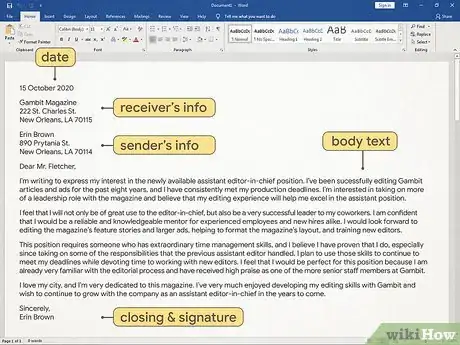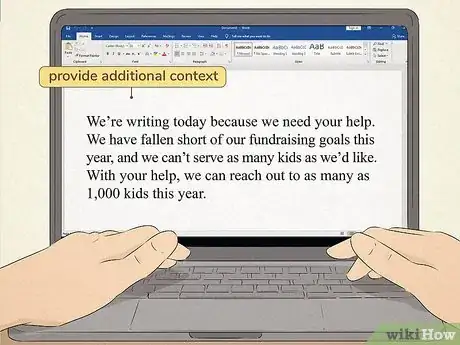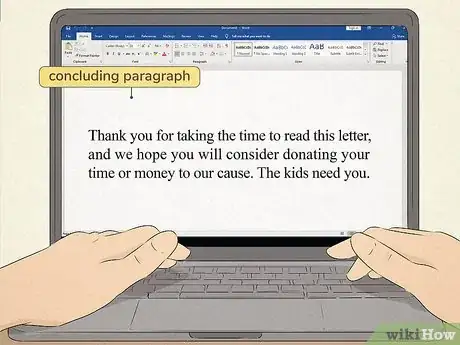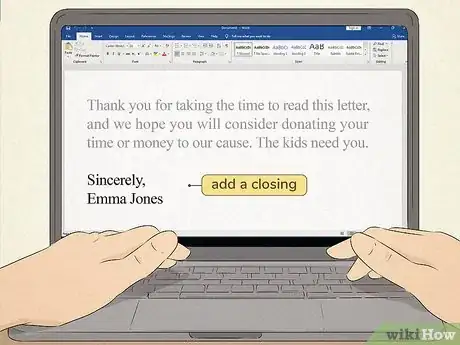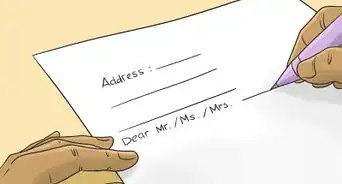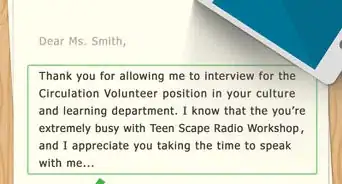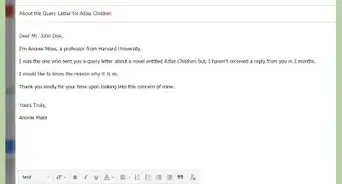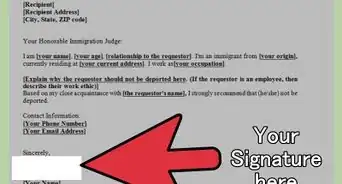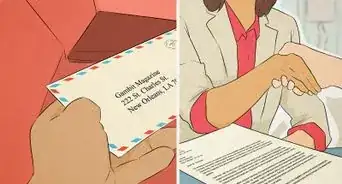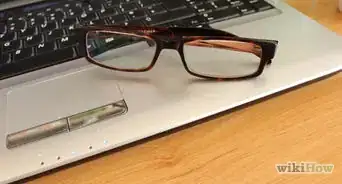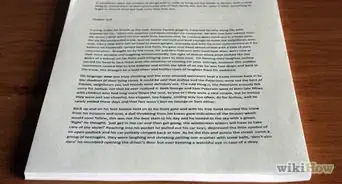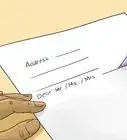This article was co-authored by Melessa Sargent. Melessa Sargent is the President of Scriptwriters Network, a non-profit organization that brings in entertainment professionals to teach the art and business of script writing for TV, features and new media. The Network serves its members by providing educational programming, developing access and opportunity through alliances with industry professionals, and furthering the cause and quality of writing in the entertainment industry. Under Melessa's leadership, SWN has won numbers awards including the Los Angeles Award from 2014 through 2021, and the Innovation & Excellence award in 2020.
This article has been viewed 452,367 times.
At some point, most people have to write a letter of request for something. Whether it's a charitable contribution, a chance to make up a missed exam, a meeting with an expert in your field, or a document you need for a report you're writing, the style for writing these letters remains the same. Follow these instructions to make your letter of request more professional and persuasive.
Steps
Writing a Draft
-
1Use the proper format. Writing your letter in the proper, professional format of a business letter is a good way to make a positive first impression.
-
2Start with a salutation. Begin the main text of your letter with a proper, respectful salutation.
- If you know the person you are writing to, you can use their first name, e.g. "Dear Tim." Otherwise, you should use the person's last name and the proper title, (eg. Dr., Mr., Ms. or Mrs.).[3]
- If you do not know the name of the person you are writing to, use a salutation like "Dear Sir or Madam," or "To Whom It May Concern."
Advertisement -
3Write an introductory paragraph. In the first paragraph of any letter of request, you will need to introduce yourself and clearly but briefly state the purpose of the letter, e.g. "I am writing in hopes that you will consider making a contribution to the Boston Citizen's Charity Fund.[4]
- If you have had any previous interaction with the recipient of your letter, the opening paragraph is also a good place to remind them of the nature of your association or the contact you've had in the past.[5]
- For example: "I am a student in your drama 101 class," "I'm the president of the Boston Citizens Charity Fund, an organization you've generously donated to for the last 10 years," or "I contacted you last month about the possibility of a class trip to your amusement park."
- Establishing a connection is not only helpful to the recipient but may also promote feelings of affinity with you that might increase the chances of your request being granted.
-
4Write a body paragraph. Your body paragraph (or paragraphs) should provide additional context and information and more specific details about your request.[6] This is your opportunity to spell out exactly what you are asking for and make your case for why your request should be granted.
- Be thorough but brief. You should clearly explain what it is you are requesting and why the matter is worthy of consideration, but your reader will not want to read your life story.[7]
- Be straightforward and specific about what you are requesting. The receiver should be left with no doubt as to what you want.[8] For example: "I'm hoping you'll consider repeating your generous contribution this year," or "I'd like to respectfully request an opportunity to resubmit this paper."
- Be courteous and use a tone that is appropriate for your reader.[9]
- Be factual and keep your emotions in check. If you must discuss your feelings about a matter, state them factually rather than emotionally, e.g. "I was very disappointed when I saw my grade," not "I'm so mad about this grade!"[10]
-
5Write a concluding paragraph. In your concluding paragraph, you should make your recipient aware of any relevant time constraints you face,[11] and also express your gratitude for their consideration of your request.[12]
- For example, if you are writing to request information or a meeting with someone that must occur before a certain date to be of any use to you, politely make that clear in the conclusion.
- Even if your recipient ultimately does not grant your request, the fact that they have taken the time to read your letter and consider your wishes is worthy of thanks.
-
6Add a closing. Finally, your letter needs an appropriate and polite closing. Good options include "Respectfully," "Sincerely," or "Best regards," followed by your name.[13]
- If you are sending a physical letter, leave four lines of empty space between the closing and your typed name. In this space, sign your name with a pen.
- If you are enclosing any materials with your letter, this information should come after your closing, e.g. "Enclosures: 2."[14]
Finalizing the Letter
-
1Cool off. After finishing the first draft of your letter, set it aside for a few days, if time permits. This will give you a different perspective on it when you return to it.[15]
-
2Edit and rewrite the letter. Give the letter a close reading to make sure your writing is clear, flows well, and accomplishes the goals you set out to accomplish in part 1. Make any necessary revisions.
- A good way to assess your writing is to read your letter out loud. This will help you to notice any missing words and generally get a sense of whether the language flows well and strikes the appropriate tone.[16]
-
3Proofread the final draft. After you've made any substantive edits, give the letter one more look to catch any spelling and grammar mistakes that you might have missed the first time.
- It's a good idea to have someone else read your letter for this purpose as well. It is much easier to overlook your own errors.[17]
-
4Send your letter. Send your letter to its recipient. If you are sending a physical letter, be sure to include a current and professional-looking stamp. In the top left of the envelope, put your name, title (if applicable), and return address. In the bottom middle, include the recipient's name and address. Make sure you keep a copy for your records until the matter is settled.[18]
Preparing to Write
-
1Brainstorm the big ideas. In order to write a clear, effective letter, it is crucial that you have a clear sense of your goals and the letter's purpose.
- A good way to make sure your thoughts about these topics are clear is to get three blank pieces of paper and label them "why I am writing this letter," "the purpose of this letter," and "other thoughts."[19]
- Without worrying too much about details, take a few minutes and write down your thoughts about the letter on these three pieces of paper. Make lists and brainstorm the big picture ideas you have about the situation that has prompted you to write the letter, what you hope the letter will achieve, and any other important information you think may need to be included.
-
2Consider your audience. Essential to setting the right tone in your letter is understanding the audience you are writing for.[20] After your initial brainstorm, on another piece of paper, write down what you know about the recipient of your letter.
- For example, what is this person's position, and how can he or she be of help? Will this person be making a final decision about your request, or making a decision about whether or not to pass your request on to a higher authority?
- It's also a good idea to consider the recipient's knowledge of the topic you are writing about. If your reader is not well versed in the topic you are writing about, this will necessitate a different type of writing (i.e. use of simpler language and the inclusion of more background information) than if your recipient is already an expert on the matter.
-
3Make an outline. Finally, before you begin actually composing the letter, create an outline to organize your thoughts into a logical, coherent order.[21]
- Consider the main points you want to make and the secondary points you will use to support those points. Make sure your ideas are organized in a way that will make sense to your reader.
Community Q&A
-
QuestionHow do I write a letter to a club requesting privacy screens be put on the gym windows that face the street where people are walking past all the time?Find the address of the club, write your letter, send it. However, most clubs spend a lot of time considering their interiors, including windows to the outside, and what that does psychologically to the patrons. I assume this club would have also given this careful thought before choosing to make the interior visible to passers-by, so your request is not guaranteed to get the result you'd like, and you may need to find a new club that better suits your preference.
Warnings
- Don't try to manipulate your reader with emotional appeals, threats, or unrealistic promises.[25] These types of appeals are more likely to offend your reader than persuade them.⧼thumbs_response⧽
- Bad spelling and grammar can damage an otherwise well-written letter.[26] It can be distracting to your reader, and can create the impression that you don't care enough about your request to get it right. Always proofread, and whenever possible get a second reader to look at your letter.⧼thumbs_response⧽
References
- ↑ http://studentaffairs.sdsu.edu/ombuds/writingappeal.html
- ↑ https://www.ablebits.com/office-addins-blog/2014/04/04/request-letters-format-samples/
- ↑ https://www.ablebits.com/office-addins-blog/2014/04/04/request-letters-format-samples/
- ↑ http://studentaffairs.sdsu.edu/ombuds/writingappeal.html
- ↑ http://www.writeexpress.com/request-letters.html
- ↑ https://www.ablebits.com/office-addins-blog/2014/04/04/request-letters-format-samples/
- ↑ http://www.writeexpress.com/request-letters.html
- ↑ http://www.writeexpress.com/request-letters.html
- ↑ http://www.writeexpress.com/request-letters.html
- ↑ http://studentaffairs.sdsu.edu/ombuds/writingappeal.html
- ↑ http://www.blairenglish.com/exercises/emails/exercises/formal_email_request/formal_email_request.html
- ↑ http://www.writeexpress.com/request-letters.html
- ↑ https://www.ablebits.com/office-addins-blog/2014/04/04/request-letters-format-samples/
- ↑ https://www.ablebits.com/office-addins-blog/2014/04/04/request-letters-format-samples/
- ↑ http://www.wrightslaw.com/advoc/articles/12rules_letters.htm
- ↑ https://www.ablebits.com/office-addins-blog/2014/04/04/request-letters-format-samples/
- ↑ http://www.wrightslaw.com/advoc/articles/12rules_letters.htm
- ↑ http://studentaffairs.sdsu.edu/ombuds/writingappeal.html
- ↑ http://www.wrightslaw.com/advoc/articles/12rules_letters.htm
- ↑ https://www.ablebits.com/office-addins-blog/2014/04/04/request-letters-format-samples/
- ↑ http://www.writeexpress.com/writing-outline.html
- ↑ http://studentaffairs.sdsu.edu/ombuds/writingappeal.html
- ↑ http://studentaffairs.sdsu.edu/ombuds/writingappeal.html
- ↑ http://www.writeexpress.com/request-letters.html
- ↑ http://studentaffairs.sdsu.edu/ombuds/writingappeal.html
- ↑ https://www.ablebits.com/office-addins-blog/2014/04/04/request-letters-format-samples/
About This Article
To write a letter of request, start by greeting the recipient with “Dear,” followed by the person’s last name and title, or “To Whom It May Concern.” Then, briefly explain who you are and why you’re writing in the 1st paragraph. Next, provide additional context and details about your request in the 2nd paragraph. After that, use the 3rd paragraph to note any time constraints, and express your appreciation for their consideration. Finally, close with something like “Sincerely” or “Respectfully,” and your signature. For more information, including how to format your letter so it looks professional, read on!
